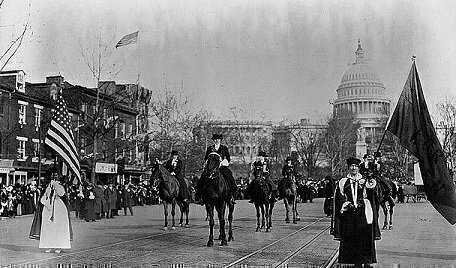The right to vote has long been considered one of the cherished freedoms key to American democracy. But voting rights in general were very limited in the Founders’ time and have changed greatly since then.
 The Constitution took effect in early 1789 after the first federal elections. It did not include an express protection of the right to vote, and it was left to the states to determine who was eligible to vote in elections. For the most part, state legislatures generally limited voting to white males who owned land. Some states also utilized religious tests to ensure only Christian men could vote. Gradually, state legislatures began to slightly expand voting rights to non-landowning white males.
The Constitution took effect in early 1789 after the first federal elections. It did not include an express protection of the right to vote, and it was left to the states to determine who was eligible to vote in elections. For the most part, state legislatures generally limited voting to white males who owned land. Some states also utilized religious tests to ensure only Christian men could vote. Gradually, state legislatures began to slightly expand voting rights to non-landowning white males.
However, it wasn’t until 1870 when the 15th Amendment was ratified that the right to vote was drastically expanded at least in the Constitution’s text by ensuring the right to vote could not be denied based on race. (And although the 15th Amendment extended the right to vote to all citizens regardless of race, Native American people born in the United States were not recognized as full American citizens until the Snyder Act and therefore did not have the right to vote until 1924.)
Little by little, additional barriers were broken down and the franchise was extended to additional groups of people. Three additional constitutional amendments expanded the right to vote. The 19th Amendment, ratified in 1920, ensured the right to vote shall not be denied or abridged on account of sex. The 24th Amendment, ratified in 1964, prohibited Congress and the states from implementing a poll tax or other types of tax for federal elections. And the 26th Amendment, ratified in 1971, stated no citizen at least 18 years of age or older may be denied the right to vote on the account of age.
Despite this forward progress over time, expanding the franchise did not come without pushback. Some state legislatures implemented strategic policies such as poll taxes and literacy tests to reduce voting among people of color, Native Americans, immigrants and low-income populations. These policies remained in effect for decades until Congress passed the Voting Rights Act of 1965. The act was designed to make sure state and local governments could no longer pass laws or policies that denied citizens the right to vote based on race and other immutable characteristics. This monumental voting rights legislation was expanded several times: in 1975 to protect language minorities, in 1982 to require accommodations and protections for voters with disabilities, and in 1993 to permit voter registration at the motor vehicle departments.
In 2013, the Supreme Court weighed in on the Voting Rights Act in a significant way in the Shelby County v. Holder case. At issue was whether Section 5 of the Voting Rights Act –a provision of the act that required jurisdictions with a history of discrimination to submit proposed changes in voting procedures to the U.S. Department of Justice—was constitutional. A majority of the court held Section that 4(b) – the provision that determined which jurisdictions were covered by Section 5 – was unconstitutional because it was based on an old formula. In effect, Section 5 became unenforceable until Congress designated a new formula. Shortly thereafter, states such as North Carolina, Texas, Alabama, Mississippi, Florida, and Virginia began to implement policies previously denied under Section 5 of the Voting Rights Act.
In the post-Shelby County era, cases continue to arise about the constitutionality of various electoral laws and policies in different states, and how they comport with other provisions of the Voting Rights Act such as Section 2, which prohibits voting practices or procedures that discriminate based on race, color, or membership in a language minority group. The Supreme Court in Brnovich v. DNC is currently considering whether Arizona’s out-of-precinct policy and ban of third-party collection of ballots violates Section 2, and as part of that ruling, may determine what legal standard to use to evaluate claims under Section 2 going forward.
The right to vote in America has evolved tremendously since 1789. In 2020, for the first time in this nation’s history, over 159 million people voted in a presidential election. This demonstrates that objectively speaking more Americans than ever are exercising their right to the franchise.
Angelys Torres McBride is a former legal studies intern at the National Constitution Center.







